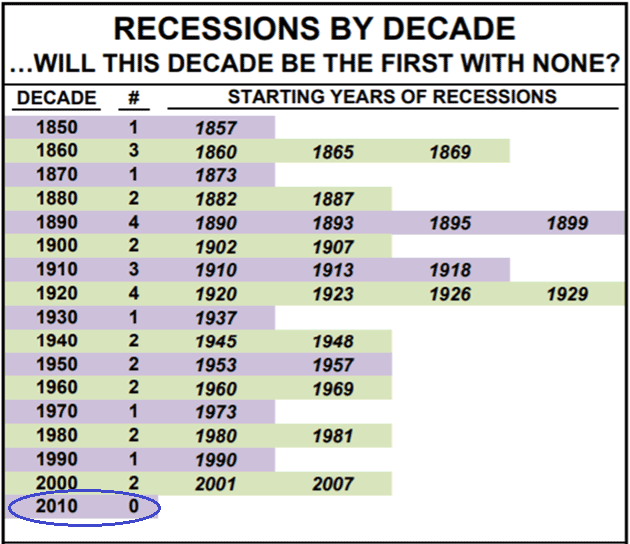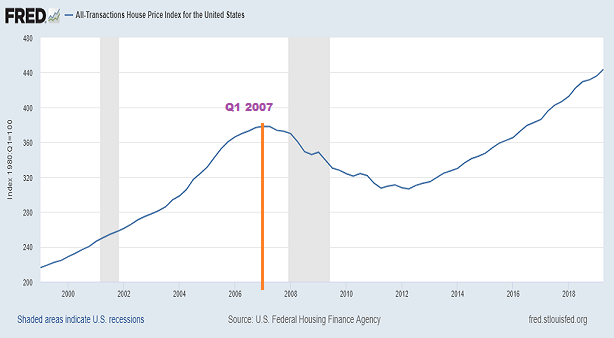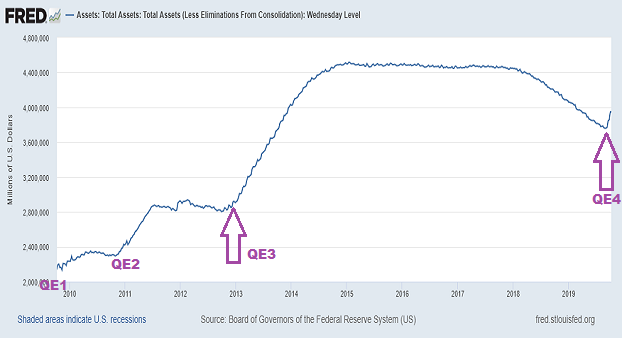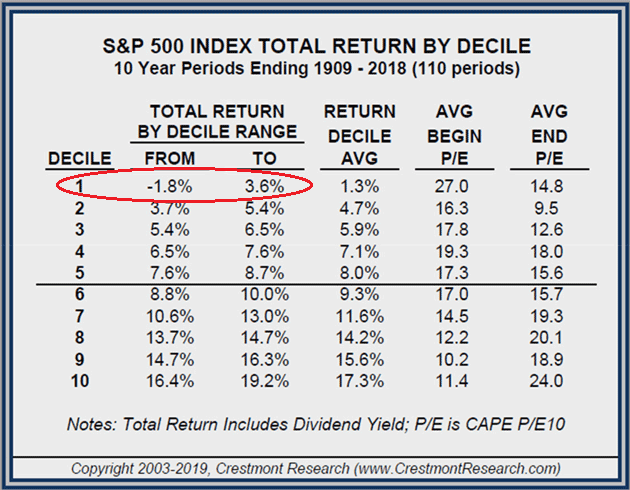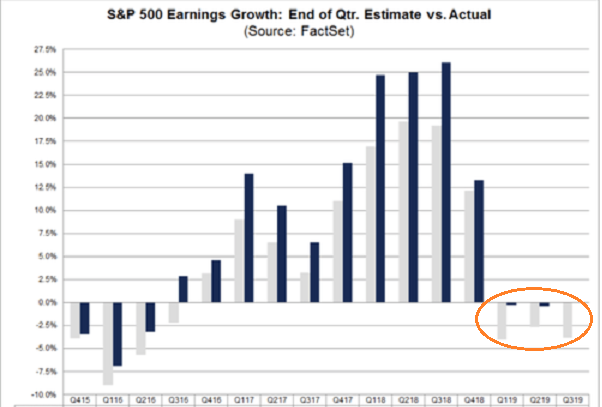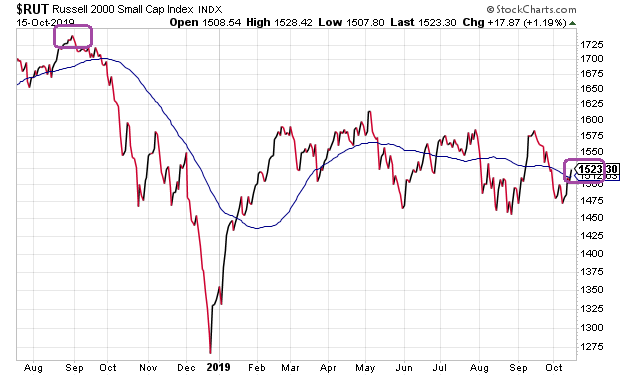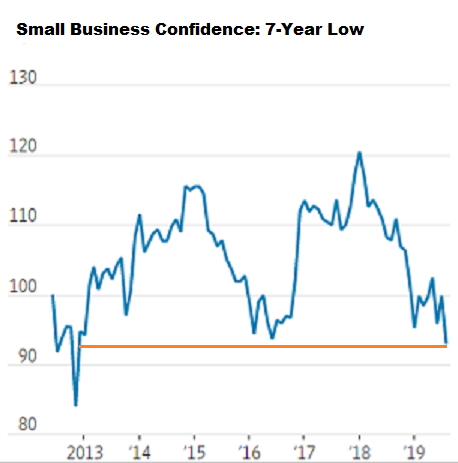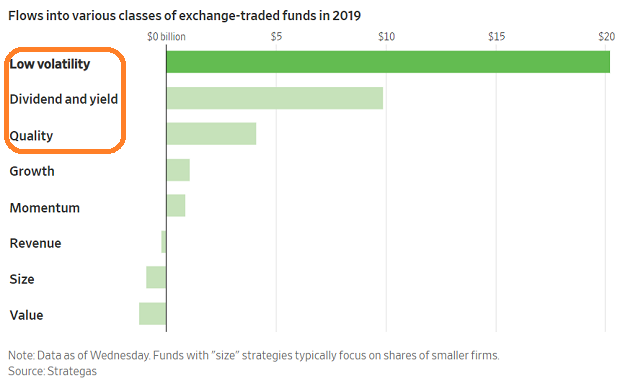By Gary Gordon, Pacific Park Financial, Inc.
Many investors are aware that the current economic expansion is the longest in U.S. history. 10 years and six months.
Some believe that the growth does not need to end. Ever. They quip, “Economic expansions don’t die of old age.”
Others wonder if the business cycle will end soon. After all, every decade on record has experienced at least one recession.
The problem with focusing on when the next recession will occur? It assumes that asset prices decline dramatically because an economy shrinks. That has not been the case in the 21st century.
Here in the 21st century, causation has been turned on its head. Recessions did not cause stocks, bonds and real estate to get crushed; rather, asset price decimation caused the recessions that transpired.
Consider the 2001 recession. It came about due to the bursting of the tech bubble in March of 2000. Severe stock price depreciation, particularly in dot-com names, led to the layoff of millions of employees and to a painful pullback in consumer spending. Indeed, a vicious bear had been clobbering stocks for a full year prior to the 2001 recession.
What about the Great Recession (12/2007-5-2009)? The housing bubble actually burst in the first quarter of 2007, 10 months prior to the December time stamp. What’s more, it wasn’t until late in the 3rd quarter of 2008 that recessionary pressures were being acknowledged.
Voting members of the Federal Reserve understand this 21st century dynamic. Not surprisingly, then, committee members will do whatever it takes to keep asset prices afloat.
Most recently, the Fed began “QE4.” Nobody wants to call it that. Yet when a central bank creates trillions of electronic dollar credits out of thin air to buy assets, and never gets rid of those credits, the central bank has engaged in electronic money printing.
The Federal Reserve is purchasing $60 billion a month in securities from the open market. That’s as much quantitative easing (QE) as what occurred during the financial crisis in 2008. The question people should be asking is what emergency currently exists such that the Fed needs a new program of asset purchasing straight through the 2nd quarter of 2020?
The Fed wants the new “money” to wind up in stocks, bonds and real estate. That is how they hope to extend the longest expansion in history. Never mind the fact that manipulating interest rates lower makes it possible for consumers, businesses and governments to borrow for even less.
What could possibly go wrong?

There are those who maintain that the Fed is being sensible. Yet they’re ignoring the adverse impact on future returns for bond holders and savers. Even worse? When short-, medium- and long-term rates are as depressed as they are, retirees and near-retirees feel coerced into taking on larger risks to meet needs.
What about the future return prospects for equities? At current valuation levels, the next decade could offer a whole lot of risk and not much in the way of gain.
There’s more. Corporate earnings will likely shrink for a third consecutive quarter. That could make stock valuations even foamier.
It is also worth remembering that large-cap U.S. stock enthusiasm is not matched by smaller companies. The Russell 2000 Small Cap Index has been in a rut for over a year. In fact, prices are 12.3% LOWER than they were at their peak in September of 2018.
One explanation? Small business confidence has been dropping precipitously. It recently registered a 7-year low.
Indeed, investors may already be bracing for atrocious losses. Assets with lower perceived risk have been garnering the lion’s share of investment dollars throughout 2019.
If you are nearing retirement, there are no easy answers. A traditional portfolio of stocks and bonds — 60/40, 50/50 — may go nowhere for a decade. Or bearish losses may take the better part of the next 7-10 years to recover.
Dividend income may be reliable from the highest quality names, particularly the “dividend aristocrats.” Yet few folks will be giddy about a 2.5%-3% annual income stream should bear market price losses hit 35%, 40% or 50%. (And can you really count on a 5-year break-even time horizon?)

Despite the fact that rate-sensitive investments (e.g., dividends, REITs, utilities, preferred stock, etc.) are part of a “crowded trade,” I still favor them. I like exchange-traded trackers such as SPDR S&P Dividend ETF (SDY), iShares Core REIT ETF (USRT) and Van Eck Market Vectors Preferred Ex Financials (PFXF).
Nevertheless, I am aware that the positioning is a crowded one and that tactical asset allocation changes will become necessary. “Hope-n-hold-everything” may work for some folks. Others can appreciate the power of losing less in a violent market meltdown.
Disclosure Statement: ETF Expert is a web log (“blog”) that makes the world of ETFs easier to understand. Gary Gordon, MS, CFP is the president of Pacific Park Financial, Inc., a Registered Investment Adviser with the SEC. Gary Gordon, Pacific Park Financial, Inc., and/or its clients may hold positions in the ETFs, mutual funds, and/or any investment asset mentioned above. The commentary does not constitute individualized investment advice. The opinions offered herein are not personalized recommendations to buy, sell or hold securities. At times, issuers of exchange-traded products compensate Pacific Park Financial, Inc. or its subsidiaries for advertising at the ETF Expert website. ETF Expert content is created independently of any advertising relationship.
This article was republished with permission from Pacific Park Financial, Inc.. View the original article here.


